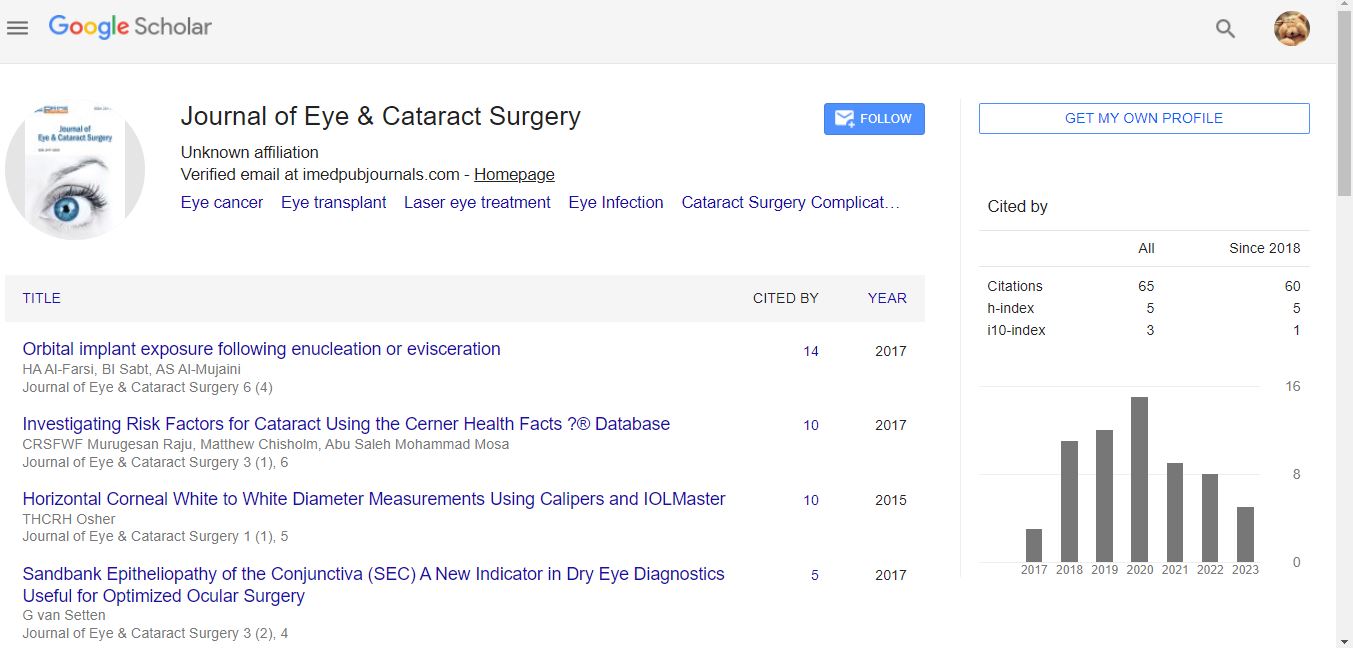Commentary - (2024) Volume 10, Issue 4
Eye Cancer: Understanding the Disease, Diagnosis, Treatment, and Outlook
Marie Therese*
Department of Ophthalmology, University of Naples Federico, Italy
*Correspondence:
Marie Therese,
Department of Ophthalmology, University of Naples Federico,
Italy,
Email:
Received: 02-Dec-2024, Manuscript No. IPJECS-25-22556;
Editor assigned: 04-Dec-2024, Pre QC No. IPJECS-25-22556 (PQ);
Reviewed: 18-Dec-2024, QC No. IPJECS-25-22556;
Revised: 23-Dec-2024, Manuscript No. IPJECS-25-22556 (R);
Published:
30-Dec-2024, DOI: 10.36648/2471-8300.10.4.32
Description
Eye cancer, although rare, is a serious condition that can significantly impact a person's vision and overall quality of life. It occurs when abnormal cells begin to grow uncontrollably within the eye, forming a tumour. While most eye cancers are localized to the eye, in some cases, they can spread to other parts of the body. Early detection and treatment of eye cancer are crucial for improving prognosis and preserving vision. In this article, we will explore the different types of eye cancer, their symptoms, causes, methods of diagnosis, treatment options, and the outlook for those affected by the disease. Eye cancer can be classified into two main categories: primary eye cancer and secondary eye cancer. Primary eye cancer originates in the eye, whereas secondary eye cancer occurs when cancer from another part of the body spreads (metastasizes) to the eye. Primary eye cancers are rare, but when they do occur, they are often diagnosed in individuals with a family history of the disease or those with certain risk factors. The most common types of primary eye cancer include. This is the most common eye cancer in children, typically affecting those under the age of 5. Retinoblastoma develops in the retina, the light-sensitive layer at the back of the eye. It can affect one or both eyes and may present with symptoms such as a white reflection in the pupil, crossed eyes, or vision problems. If not treated promptly, retinoblastoma can spread to other parts of the body. Uveal melanoma is the most common form of eye cancer in adults. It develops in the uvea, the middle layer of the eye that consists of the iris, ciliary body, and choroid. Uveal melanoma is most often diagnosed in individuals aged 50 and older. Symptoms may include blurred vision, dark spots in the field of vision, or a change in the shape of the pupil. Uveal melanoma is a potentially aggressive cancer that can spread to other organs, particularly the liver. Conjunctival melanoma is a rare form of eye cancer that develops on the conjunctiva, the thin membrane that covers the white part of the eye and the inside of the eyelids. It typically manifests as a dark spot or growth on the surface of the eye. Although less common than uveal melanoma, conjunctival melanoma can be aggressive and may require surgery, radiation therapy, or other treatments. Intraocular lymphoma is a rare cancer that develops in the lymphatic tissue of the eye, often as a result of a primary lymphoma that has spread to the eye. It typically affects older adults and can lead to symptoms such as blurred vision, floaters, and eye inflammation. Treatment often involves chemotherapy, radiation, or a combination of both. Secondary eye cancer, also known as metastatic eye cancer, occurs when cancer cells from other parts of the body spread to the eye. This is more common than primary eye cancer, and it can occur when cancers such as breast cancer, lung cancer, or melanoma metastasize to the eye. The most common sites of metastasis to the eye are the choroid (the blood vessel-rich layer of the eye) and the retina.
Acknowledgement
None.
Conflict Of Interest
The author's declared that they have no conflict of interest.
Citation: Therese M (2024) Eye Cancer: Understanding the Disease, Diagnosis, Treatment, and Outlook. J Eye Cataract Surg. 10:32.
Copyright: © 2024 Therese M. This is an open-access article distributed under the terms of the Creative Commons Attribution License, which permits unrestricted use, distribution, and reproduction in any medium, provided the original author and source are credited.

